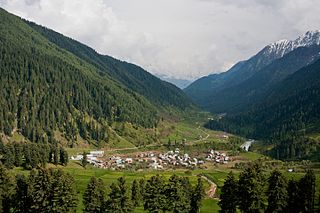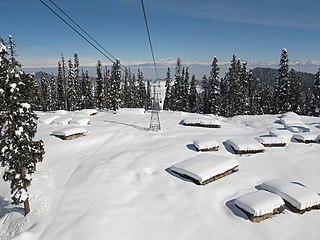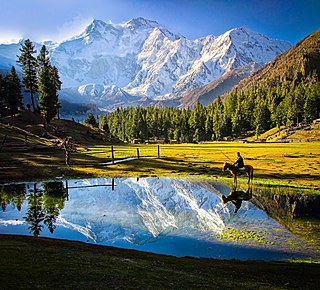Related Research Articles

Gulmarg, known as Gulmarag in Kashmiri, is a town, hill station, tourist destination, skiing destination, and a notified area committee in the Baramulla district in the Indian union territory of Jammu and Kashmir. It is located at a distance of 31 km (19 mi) from Baramulla and 49 km (30 mi) from Srinagar. The town is situated in the Pir Panjal Range in the Western Himalayas and lies within the boundaries of Gulmarg Wildlife Sanctuary.
Indian Institute of Skiing and Mountaineering (IIS&M) was established in 1969 at Gulmarg by the Department of Tourism and the Government of India. The institute is chartered to train skiers and mountaineers from all over the world.

Pahalgam, known as Pahalgom is a town and a notified area committee, near Anantnag city in the Anantnag district of the Indian-administered union territory of Jammu and Kashmir. It is a popular tourist destination and hill station. Its lush green meadows and pristine waters attract thousands of tourists from all over the world each year. It is located 45 kilometres (28 mi) from Anantnag on the banks of Lidder River at an altitude of 7,200 feet (2,200 m). Pahalgam is the headquarters of one of the eleven tehsils of Anantnag district.

Jammu and Kashmir is home to several valleys such as the Kashmir Valley, Chenab Valley, Sindh Valley and Lidder Valley. Some major tourist attractions in Jammu and Kashmir are Srinagar, with its renowned Dal Lake and Mughal Gardens, Gulmarg, Pahalgam, Bhaderwah, Patnitop and Jammu. Every year, thousands of Hindu pilgrims visit holy shrines of Vaishno Devi and Amarnath which has had a significant impact on the state's economy.

Jawahar Tunnel, also called Banihal Tunnel is a road tunnel at elevation of 2,194 m (7,198 ft) in Union Territory of Jammu and Kashmir in India below the Banihal Pass in the Pir Panjal mountain range in lower Himalayas. It was named after Jawaharlal Nehru, the first Prime Minister of India. It was constructed between 1954 and 1956. It has been operational since 22 December 1956. The length of tunnel is 2.85 km. It has two parallel tubes of one lane road in either direction. It is situated between Banihāl and Qazigund on NH 1A that has been renumbered NH 44. The tunnel facilitates round-the-year road connectivity between Srinagar and Jammu.

Military operations took place in Poonch district, then part of the princely state of Jammu and Kashmir, in 1948 during the conflict in Jammu and Kashmir between the Indian Army and Pakistani and Azad Kashmir rebel forces. Poonch withstood a siege by these forces from November 1947 until relieved by an Indian offensive, Operation Easy on 20 November 1948. The besieged garrison, commanded by Brig. Pritam Singh, was maintained by air supply. Military operations ended with Poonch town and the eastern part of Poonch district in Indian hands and western part of the Poonch district in Pakistani hands.

Aru known as Adav in Kashmiri, is a village, tourist spot in the Anantnag District of Jammu and Kashmir, India. It lies 53km from Anantnag city, the district headquarter. It is located around 12 km from Pahalgam, 11 km upstream from the Lidder River. Noted for its scenic meadows, lakes and mountains, it is a base camp for trekking to the Kolhoi Glacier, Tarsar Lake, Marsar and Herbaghwan Lake. The village lies on the left bank of the Aru river, which is a tributary of the Lidder river. Jammu & Kashmir’s biggest Fodder Seed Product Station is also located in the Aru village.

Kolahoi Peak is a mountain with peak elevation of 5,425 metres (17,799 ft) located in Lidder Valley, Jammu and Kashmir. Kolahoi Peak is easily accessible through Aru Pahalgam. The mountain is the highest mountain in Kashmir Division. Kolahoi Peak is part of the Great Himalayan range, and is located 16 km south of Kashmir. Accessible through the pathway of Aru Pahalgam, this mountain stands tall as the crowned jewel of the Kashmir Division.
Winter sports are common in India in the Himalayan areas. Ski tournaments take place every winter in Gulmarg, Kashmir and Manali. Winter sports are generally more common in the northern states of Jammu and Kashmir, Himachal Pradesh, Uttarakhand, Sikkim and Arunachal Pradesh. Skiing, snow rugby, snow cycling and snow football are few of the common sports played in India. Skiing is more popular although India has taken part in Luge in Winter Olympics since 1998. The Bandy Federation of India is headquarters are in Mandi in Himachal Pradesh. Luge is practiced in a big way by the mountain residents in an improvised form called 'Reri'.

Skiing in India is an activity that mostly takes place in the northern states of India, where the Himalayas are situated. Skiing is administered by the Indian Mountaineering Foundation in India. The Himalayas provide an excellent skiing experience owing to their great height which makes for long descents. Heliskiing is also gaining popularity in places like Manali and Gulmarg. However skiing in India suffers from lack of infrastructure. There are also security concerns in Gulmarg which is 20 km (12 mi) from the Line of Control, however since 2002, it has been peaceful, which has led to an increase in skiing activity in the region. Some of the most popular skiing locations in India are Gulmarg in Jammu and Kashmir, Solang in Himachal Pradesh and Auli in Uttarakhand. The skiing season in India is from January to March.

The Lidder Valley or Liddar Valley is a Himalayan sub-valley that forms the southeastern corner of Anantnag district in Indian-administered Kashmir. The Lidder River flows down the valley. The entrance to the valley lies 7 km northeast from Anantnag town and 62 km southeast from Srinagar, the summer capital of Jammu and Kashmir. It is a 40-km-long gorge valley with an average width of 3 km.

The Tarsar Lake or Tar Sar is an almond-shaped, oligotrophic alpine lake situated in the Anantnag district of Jammu and Kashmir. On its west side lies Dachigam National Park, and on its south side lies Tral. The shortest route for reaching it, is from Surfraw Ganderbal, but it has a difficult terrain. Other trek routes to the lake are from Lidderwat and Nagaberan forest areas which fall in south Kashmir.

Mountaineering is quite popular in India, since the entire northern and north-eastern borders are the Himalayas, the highest mountain range in the world. The apex body in India is the Indian Mountaineering Foundation, which is affiliated to the International Federation of Sport Climbing.

The Western Himalayas are the western half of the Himalayas, in northwestern India and northern Pakistan. Four of the five tributaries of the Indus River in Punjab rise in the Western Himalayas; while the fifth, the Sutlej cuts through the range after rising in Tibet.

Panchtarni is a locality in Anantnag district of the Indian union territory of Jammu and Kashmir. It is a popular pilgrimage and tourist destination on the way to Amarnath Temple near the Amarnath Glacier in Himalayas. It is located 40 kilometres (25 mi) from Pahalgam base camp and 15 kilometres (9.3 mi) ahead of last halt camp of Sheshnag Lake in the north. It is a meadowland on the banks of eponymous Panchtarni River where five glacier-fed tributary streams meet in eponymous Panchtarni Valley surrounded by snow-capped mountains at an altitude of 11,500 feet (3,500 m). It is also the final helicopter drop off for the Amarnath yatra pilgrims, who have to trek the rest of the 6 kilometres (3.7 mi) journey either on foot or by mule from this camp.

Popular sports in Jammu and Kashmir include cricket, football and winter sports along with sports like golf, water sports, Ice stock sport and adventure sports. The National Winter Games have been held in Gulmarg in 1996, 2004 and 2009. The first Khelo India Winter Games were held in February and March 2020 in Leh and Gulmarg. Jammu and Kashmir won the most gold medals while the Indian Army team came second with 8 gold medals. The second edition of the winter games were also held successfully in Gulmarg in 2020 with Jammu and Kashmir coming first and Karnataka second.

Jammu and Kashmir is a region administered by India as a union territory and consists of the southern portion of the larger Kashmir region, which has been the subject of a dispute between India and Pakistan since 1947 and between India and China since 1959. The Line of Control separates Jammu and Kashmir from the Pakistani-administered territories of Azad Kashmir and Gilgit-Baltistan in the west and north. It lies to the north of the Indian states of Himachal Pradesh and Punjab and to the west of Ladakh which is administered by India as a union territory.

The Nehru Institute of Mountaineering in Uttarkashi in Uttarakhand is an institute that was established on November 14, 1965. The institute was formed to honor the great desire of Jawahar Lal Nehru, the first Prime Minister of India.

Dipankar Ghosh was an Indian mountaineer from West Bengal. He is the first Bengali to climb Mount Everest and had successfully climbed five other eight-thousand-meter peaks besides Mount Everest. In 2019, the Government of India posthumously honored him with the Tenzing Norgay National Adventure Award for the year 2018, the highest adventure sports honor in India. He died in 2019.
References
- ↑ "Nehru Institute Of Mountaineering".
- ↑ "Unexplored Kashmir – Aru, Lidderwat Valley". 23 May 2014.
- 1 2 "JAWAHAR INSTITUTE OF MOUNTAINEERING & WINTER SPORTS, NUNWAN, PAHALGAM".
- ↑ "A brief history of the Kashmir conflict". 24 September 2001.
- ↑ "Unexplored adventure sports heaven". 27 August 2016.
- ↑ "Jawahar Institute of Mountaineering & Winter Sports, Nunwan, Pahalgam".
- ↑ "Review: Basic Skiing Course at JIM & WS- Ski Out Your Heart". 12 May 2020.